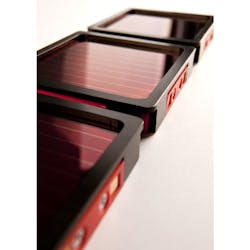New organic solar cell architecture sets 6.9% efficiency record
Leuven, Belgium--At this week's 2011 European Union Photovoltaic Solar Energy Conference and Exhibition (EU PVSEC) in Hamburg, Belgian research center imec, in partnership with printed optoelectronics company Plextronics (Pittsburgh, PA) and chemistry company Solvay (Brussels, Belgium), unveiled a polymer-based, single-junction organic solar cell with 6.9% optical-to-electrical conversion efficiency performance in a new inverted device stack. The cell combines imec's scalable inverted device architecture and Plextronics' polymers to achieve new levels of cell efficiency—at least 0.5% more efficient than standard architectures used for organic solar cells. The polymer was also integrated into a module resulting in excellent module-level efficiencies of 5% for an aperture area of 25 square centimeters.
Organic solar cells are regarded as an emerging technology to become one of the low-cost thin-film solar alternatives to the current dominating silicon photovoltaic technology, due to their intrinsic potential for low-cost processing (high-speed and at low temperature). Inverted architectures are developed to extend the lifetime of organic solar cells, an investigation which is currently ongoing for this new architecture. In the active layer, a new buffer layer was introduced to optimize the light management in the device. Imec’s innovative device architecture, combined with Plextronics’ low band-gap p-type polymer with a fullerene derivate, resulted in a stabilized certified conversion efficiency of 6.9%, which is the highest performance obtained for this polymer material and, to our knowledge, the highest efficiency reported for inverted architectures.
Tom Aernouts, R&D team leader Organic Photovoltaics at imec, said, "With further optimizations to the material as well as to the architecture, for example by introducing a multi-junction featuring different layers of different polymers each capturing another part of the light spectrum, we envision organic solar cell lifetimes of over 10 years and conversion efficiencies of 10% in two to three years, ultimately aiming at industry-relevant solutions."
SOURCE: imec; www2.imec.be/be_en/press/imec-news/imecplextronicssolvayopv.html

Gail Overton | Senior Editor (2004-2020)
Gail has more than 30 years of engineering, marketing, product management, and editorial experience in the photonics and optical communications industry. Before joining the staff at Laser Focus World in 2004, she held many product management and product marketing roles in the fiber-optics industry, most notably at Hughes (El Segundo, CA), GTE Labs (Waltham, MA), Corning (Corning, NY), Photon Kinetics (Beaverton, OR), and Newport Corporation (Irvine, CA). During her marketing career, Gail published articles in WDM Solutions and Sensors magazine and traveled internationally to conduct product and sales training. Gail received her BS degree in physics, with an emphasis in optics, from San Diego State University in San Diego, CA in May 1986.
